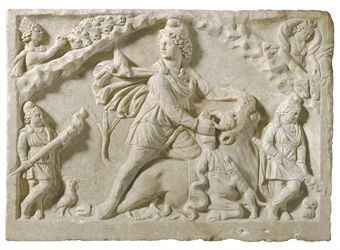At the moment I am looking at a mysterious Roman title, the Pater Patratus, of uncertain meaning. Yesterday I looked at the passage in Livy which gives us most information about it. Today I decided to look at inscriptional evidence.
A search of the Clauss-Slaby database reveals only three inscriptions which use the title of “Pater Patratus”, whatever it may mean. Here they are:
Reference: CIL 02, 02705 = CIL 02, 05728 = ERAsturias 00007 = D 04209 = CIMRM-01, 00803 = CIMRM-02, p 35 = HEp-07, 00018
Province: Hispania citerior Place:Isla
Ponit Inv/icto deo / Au(gu)sto po/nit l<i=E>b{i}en/s Fronto / aram Invi/cto deo Au(gu)/sto Pleveiu/s ponit pr(a)e/sedente pa/trem patra/tum leone / M(ithrae)
Reference: CIL 05, 05795 = D 04224 = CIMRM-01, 00706
Province: Transpadana / Regio XI Place:Milano / Mediolanum
D(eo) S(oli) I(nvicto) M(ithrae) / P(ublius) Acil(ius) Piso/nianus pater / patratus qui / hoc spel(a)eum / vii ignis ab/sumtum com/parata area a re / publ(ica) Mediol(anio) / pecunia sua / restituit
Reference: CIL 10, 00797 (p 967) = D 05004 (p 184) = AE 2000, +00243
Province: Latium et Campania / Regio I Place:Pompei
Sp(urius) Turranius L(uci) f(ilius) Sp(uri) n(epos) L(uci) pron(epos) Fab(ia) / Proculus Gellianus praef(ectus) fabr(um) II praif(ectus!) curatorum alvei / Tiberis praif(ectus!) pro pr(aetore) i(ure) d(icundo) in urbe Lavinio / pater patratus populi Laurentis foederis / ex libris Sibullinis(!) percutiendi cum p(opulo) R(omano) / sacrorum principiorum p(opuli) R(omani) Quirit(ium) nominis/que Latini quai(!) apud Laurentis coluntur flam(en) / Dialis flam(en) Martial(is) salius praisul(!) augur pont(ifex) / praif(ectus!) cohort(is) Gaitul(orum!) tr(ibunus) mil(itum) leg(ionis) X / loc(us) d(atus) d(ecreto) d(ecurionum)
The first and second of these relate to Mithras, which is the reason why we are interested in the title “Pater Patratus”. But the long inscription from Pompeii is really rather interesting also, because it shows that the title was being used in the imperial period also in something resembling its original function.
I regret that I could not find an image of the monument, or I would have placed one here. The best I can do is this[]:

I also learn from an online search that it — CIL X 797 — is a black statue-base, excavated in the 19th century from the Capitol at Pompeii and now in the museum in Naples. More interesting still, it certainly dates to the reign of Claudius, as it makes use of one of the letters introduced by that eccentric emperor to represent the ‘U’ in “Lanuvium”, as we can see above; the “digamma inversum”.
Fortunately for normal mortals, a translation may be found online. This is as follows:[]
E11 CIL X 797 = ILS 5004, AD 47-54.
Spurius Turranius Proculus Gellianus, son of Lucius, grandson of Spurius, great-grandson of Lucius, of the Fabian tribe; staff officer twice; prefect of the curators of the Tiber channel; prefect with the powers of a praetor in charge of jurisdiction in the city of Lavinium; ‘father’ of the deputation of the Laurentine people in charge of concluding the treaty with the Roman people in accordance with the Sibylline books, which relates to the rites concerned with the origins of the Roman people, the Quirites, and of the people of the Latin name, which are observed among the Laurentines; priest of Jupiter; priest of Mars; leading member of the Salii priesthood; augur and pontiff; prefect of the Gaetulian cohort; military tribune of the tenth legion (dedicated this). Space granted by decree of the town councillors.
We’re making slight progress here, I think. This official was Pater Patratus of a delegation from Lanuvium to Rome. He was a priest. He was there in order to perform a religious ritual, in order to solemnize the agreement.
This is much the same role that Livy described in I, 24, which we looked at yesterday. The pater patratus, in this period, is someone who represents a city, and performs a ritual to conclude a treaty, binding both sides by an appeal to Jupiter to punish the treaty-breaker.
Nothing in all this implies that pater patratus is a permanent office, nor that it is a position of authority. It’s rather as if the delegation select one of their number to perform the priestly side of the job. In this context we would see “patratus” as “completed”, the priest responsible for completing the ceremony.
I think we need to look at Nonius Marcellus, who quotes something from Varro about this role. But these details may help us to understand the first two inscriptions, where someone involved in the mysteries of Mithras is given this title.
Like this:
Like Loading...






